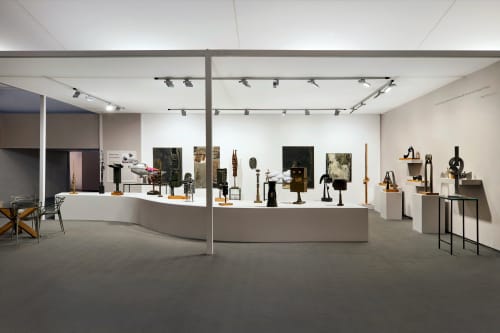Frieze Masters 2023: Stand D12
Our presentation at the 2023 edition of Frieze Masters is a celebration of the centennial of Shinkichi Tajiri (b. 1923 Los Angeles, USA - d. 2009 Baarlo, The Netherlands) with a wide selection of his sculptural works spanning seven decades, alongside four paintings by his contemporary, the Dutch Informel artist Jaap Wagemaker (b. 1906 Haarlem - d. 1972 Amsterdam). Together they participated in the seminal ZERO exhibition organised by Hans Sonnenberg in Rotterdamse Kunstkring, 1959 and represented together The Netherlands at the Venice Biennale in 1962.
Additionally, we are excited to take this opportunity to announce the recent acquisition of the major work Machine No.6, 1967 by Tate Modern, illustrated right alongside a key work on our stand Machine No.5, 1966.
Shinkichi Tajiri
Born in a family of first-generation Japanese immigrants Tajiri grew up in the USA. Following the Japanese attack on Pearl Harbour on his 18th birthday, the Tajiri family were one of many who were detained in a US internment camp. Tajiri enlisted in the all-Japanese American regiment of the American Army and was invalided out in Italy in 1944, coming back to study at the Art Institute of Chicago until 1948. That same year, with a grant from the G.I bill, he moved to Paris and studied with Ossip Zadkine and Fernand Léger, participating in the 1949 CoBrA exhibition at the Stedelijk Museum. He moved to Amsterdam in 1956.
Over the years Tajiri created a singular body of works. Although he was born in the USA and spent most of his life in Europe, the old proverb 'you can take the boy out of Japan, but you can't take Japan out of the boy', can never be truer in all Tajiri's work. Primarily a sculptor, he invented a number of new techniques (red brick casting and the elaborate use of bronze drippings) often constructing the void in his sculptures as a fundamental part of the work. Imagery of Warriors, Sentinels, Ronin and later, Knots are often recurring, these themes of war and violence were a way for Tajiri to crystalise the horrors and paradoxes he had personally experienced.
The assembled machine sculptures evoke powerful associations with modern technology and science fiction. They can still be regarded as warriors, no longer inspired from medieval but rather twentieth century weaponry. These indomitable war machines, as Tajiri called them, show a combination of speed, violence, and eroticism. However stereotypically masculine some of his works may seem, pacifism and spirituality are always apparent throughout his work. The relationship between aggression and eroticism is important, but so are the themes of fertility and growth. The later sculptures from the Knot series add a very meditative perspective to his work.
In December 2023 Tajiri will have a solo exhibition The Restless Wanderer at the Bonnefanten, Maastricht and in 2024 he will be included in the Americans in Paris exhibition at the Grey Art Museum, New York, celebrating the G.I Bill and the historical impact of the expatriate Post-War art scene.
Jaap Wagemaker
Wagemaker is the Netherlands' foremost representative of the international movement known as Informal Art or by its technical classification: 'matter painting'. In 1960 Wagemaker wins the 'Premio Marzotto'. The prize and exhibition contribute enormously to his international reputation. Wagemaker takes part in the exhibition 'The Art of Assemblage' in the New York MoMA in 1961. In addition, the MoMA buys one of his works. He is awarded the prestigious Talens Prize in the Netherlands in 1962. Major Dutch and international museums acquire his work. In 1962 he participates in the Venice Biennale. In 1965 he receives the "Association internationale des critiques d'art", the "Prix de la Critique" and in 1966 the inaugural 'Staatsprijs voor Beeldende, Kunsten en Architectuur'.







